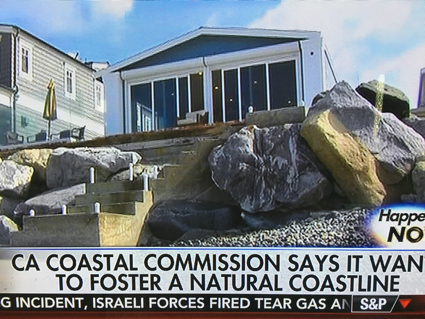The California Coastal Commission is out of control, and homeowners with beachfront property or bluff property are being told they cannot protect their house with standard small barriers, and those who have barriers (treated wood or rock boulders) are being told they cannot maintain those barriers, even if this means eventually their houses will fall into the ocean. This is an unconstitutional taking of private property, and apparently the case will go to the courts for resolution.

California Coastal Commission v. Washington
In Washington state we have a massive law called the Washington Shoreline Management Act (SMA). It may not be as onerous as the California Coastal Commission, but it does govern what you can and cannot do along any shoreline in Washington. Under the Act each city and each county with shorelines must prepare their own Shoreline Management Plan. Besides multiple jurisdictions, you may deal with more than one agency if you want to do anything along a shoreline. Each agency creates their own Regulations, and a simple matter like protecting your shoreline or bluff can become extremely complicated and even expensive with technical engineering reports required.
California Coastal Commission Awash
All this means if you want to do make improvements or maintain your shoreline in Washington, you may be in for a bureaucratic nightmare, although perhaps not as bad as the shorelines subject to the California Coastal Commission.
Building a path to the beach from your medium high bluff may not be possible. Building your own dock probably is impossible. The last gentlemen I know who built one said it cost him $100,000 in permits and studies and legal fees and many years. He started that process when he was a young man, and now he is old. Maintaining your bluff to protect your property may also be a task of epic proportions.
Read more about Sequim Bluff Stability.
Last Updated on September 6, 2019 by Chuck Marunde





























With all the homes on the coastline and removal of wetlands and natural riverine and oceanic connections – along with diversions from all the ports and human development the people in California are loosing their iconic beaches because there is not natural erosion from the sediment along the banks. The “walls” to protect one families home impacts lots of people and animals from enjoying the beaches. Thankfully the CCC is doing their job the best they can to allow access to beaches which is at a minimum in WA and protection of sediment to make sure there is a beach to go to.
I read your blog posting about negative reaction fto the California Coastal Commision and the implied similarities to the Washington and county shoreline regulations that are in place and being updated in Clallam County. The posting did refer to the complexity of bluff/shoreline protection and development.
First, I’m sure you are aware of the county draft regulations to maybe be finalized by summer’s end. Below is a link to th draft proposal reflecting that complexity.
http://www.clallam.net/LandUse/SMP_CurrentDraft.html
Second, I come down more heavily on the side of community and environmental concerns than individual property rights to do as pleased with their property – often short sighted without awareness of the effects on a very complex system as described by the work of the Costal Watershed Institute.
http://www.coastalwatershedinstitute.org/about.htm
It would seem a significant piece of due diligence on the buyers part is to educate themselves on these complexities and realities before buying property that may have significant economic risks and regulatory limitations which go far beyond infringement on individual rights or perceived violations of the Constitution.
Ask the owner off of Gasman that woke up to 40 feet of his backyard gone overnight, who spent $80,000+ to move his home and septic system away from the bluff. Most of us could not afford such a move nor have the room to make such a move. Or, those now too close to the bluffs edge to get homeowners insurance or have to pay for beach clean up after collapse of buildings onto the beach below. Some of these liabilities are caused by poorly informed regulations, poorly enforced, or circumvented.